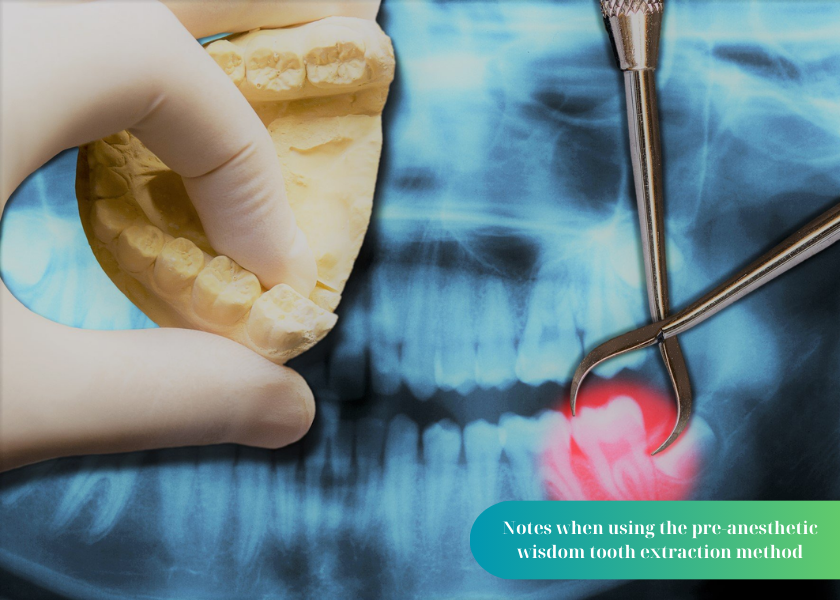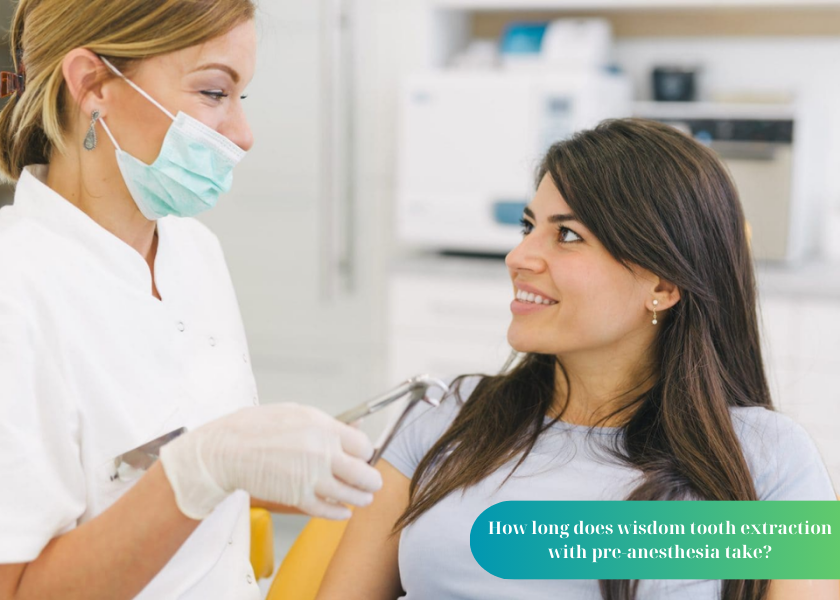What is the Pre-Anesthesia Wisdom Tooth Extraction Method? When it comes to the history of wisdom tooth extraction, many people are still haunted and afraid of pain. Even though the patient has been anesthetized, this feeling of fear still appears and affects the patient’s psychology. From there, the method of wisdom tooth extraction under anesthesia was born. In addition, there are also cases where prior anesthesia is required for the extraction process to be safe and effective.
So what is tooth extraction before anesthesia? Is it as safe for health as anesthesia? When should anesthesia be given before tooth extraction? BeamDental’s article below will help you find specific answers.
Tư vấn chuyên môn bài viết:
BÁC SĨ DƯƠNG THỊ THÙY NGA
What is the pre-anesthesia wisdom tooth extraction method?

Wisdom tooth extraction before anesthesia is a painless surgical procedure. The doctor will use painkillers and sedatives in parallel before the intervention. The purpose of pre-anesthesia is to help patients reduce anxiety and insecurity during the tooth extraction process. Because during the pre-anesthesia period, the patient will not be awake like during anesthesia. Wisdom tooth extraction before anesthesia uses sedatives to help patients reduce anxiety and insecurity during the tooth extraction process.
The pre-anesthesia tooth extraction method uses sedatives so it is safe and does not affect the respiratory and circulatory systems. Normally, pre-anesthesia will always be combined with local anesthesia to reduce pain. After waking up, the wisdom tooth problem was resolved without any sensation.
Pre-anesthesia has overcome many disadvantages of local anesthesia. If you have complex teeth, instead of anesthetizing multiple times, the doctor can perform anesthesia first to completely solve all problems in one go. This saves a lot of time and money.
Distinguishing anesthesia and pre-anesthesia: Which option is safer?
Anesthesia
Anesthesia is a method of anesthesia that will cause you to temporarily lose consciousness, sensation, and reflexes. Anesthesia will use anesthetic drugs that act directly on the central nervous system. As a result, the entire body will lose feeling and consciousness. This method is often used in large, long-term, complicated surgeries.
Under anesthesia, the patient will not be able to respond to any actions or sensations. Anesthesia may be administered intravenously or inhaled. In addition, combined anesthesia can be performed in special cases. During anesthesia, there are 3 stages:
- Pain relief: At this stage, the patient only feels sleepy. Simultaneously responds to analgesic stimuli.
- Stimulation: The patient will fall into a state of unconsciousness. There are some cases where you may fall into a state of struggle, drooling, vomiting, etc.
- Activities: Currently, the patient has completely lost consciousness and all reflexes. The respiratory system begins to become regular, the reflex to close the eyes is lost.
Important note:
During anesthesia, if the drug is stopped, the inhibitory effect will be lost. At this time, functions will gradually recover and the patient will gradually regain consciousness. But if you keep giving more medicine, especially if you overdose, it can cause spinal paralysis and death.
Pre-anesthesia
Premedication is considered a safer method than anesthesia. The doctor will use sedatives in oral or injectable form. Unlike general anesthesia, premedication is used in minor surgeries. The recovery process is also quick so patients can go home the same day.
While anesthesia can cause many complications or reactions in the body, pre-anesthesia only helps the patient relieve discomfort and pain without leaving any complications. In addition, pre-anesthesia also allows:
- Prevent secretions in the throat, mouth and respiratory system.
- Anti-stress.
- Effective pain relief.
- Reduces the risk of vomiting after surgery.
- Control body functions.
Is anesthesia or pre-anesthesia safer?

Obviously, pre-anesthesia is a much safer method than anesthesia. After anesthesia, the patient should stay in the hospital for monitoring. Before anesthesia, the patient can go home immediately and self-monitor. However, depending on the patient’s health condition and the complexity of the intervention, the doctor will choose the most appropriate method.
See more: How to fix a broken tooth? 3 remedies that you should know
Why is it necessary to apply anesthesia when removing wisdom teeth?

The obsession with wisdom tooth extraction is not unique to anyone. Even though you know that anesthesia will temporarily help you no longer feel the pain of tooth extraction, people are still confused and afraid. In addition, excessive stress also increases the risk of dangerous complications.
In addition, wisdom teeth grow differently in each person. There are people who seem to experience wisdom teeth growing crooked, growing horizontally, or growing backwards. There are also people who have to have 2 to 4 wisdom teeth extracted at the same time.
Anesthesia cannot be used in this case. Because many wisdom teeth have to be extracted at the same time, the patient feels tired. In addition, the anesthetic still retains the patient’s consciousness. Opening the mouth for such a long time will cause nausea or salivation, making the tooth extraction process unwarranted. The current optimal treatment option is pre-anesthesia. It can be seen that prior anesthesia will make the tooth extraction surgery much easier. No matter how complicated or long the case is, the dentist can safely perform tooth extraction without interruption.
In what cases should pre-anesthesia be performed when removing wisdom teeth?
Tooth extraction is essentially just a minor surgical procedure. With just local anesthesia, the patient will not feel pain. However, there are some special cases that require prior anesthesia to treat wisdom teeth, including:
Patients are always in a state of fear, panic or extreme stress due to tooth extraction. Therefore, pre-anesthesia in this case is very necessary. After being anesthetized, the tooth extraction process will take place safely, accurately and without any negative reactions from the patient.
The patient is allergic to local anesthetics. Therefore, the most optimal method of wisdom tooth extraction is prior anesthesia. Thanks to that, during the tooth extraction process, the patient does not feel any pain or discomfort.
Patients with complex wisdom tooth problems such as impacted wisdom teeth, multiple wisdom teeth extracted at the same time… Anesthesia is not enough to ensure safety in this case. Therefore, pre-anesthesia is an option that helps stabilize the mind while ensuring maximum safety and effectiveness.
Patients with chronic diseases include high blood pressure, asthma, diabetes, heart disease, kidney failure, etc. Most doctors will prescribe pre-anesthesia for these cases to avoid unfortunate complications.
See more: Piezotome Wisdom Tooth Extraction Method Using Piezotome Technology Ultrasound Machine
Is wisdom tooth extraction before anesthesia or anesthesia safer?
Anesthesia and pre-anesthesia methods allow for gentle and painless tooth extraction. However, because this is a drug that directly affects the nervous system, many people are still worried about side effects. There are some people who think that anesthesia is safer, but there are also some people who think that pre-anesthesia is safer and more effective? So is wisdom tooth extraction before anesthesia or anesthesia safer?
With anesthesia, local numbness will numb any area. During the tooth extraction process, you are still conscious of everything that is going on. Even though you know this, you will not have to feel any discomfort or pain. The advantage of anesthesia is that it provides quick recovery. However, if the tooth extraction process lasts too long, the anesthesia will run out midway, causing the entire team to be interrupted.
The pre-anesthesia method will bring better results because the pre-anesthesia effect will usually last longer than the anesthesia. In some complicated cases, it is necessary to have wisdom teeth extracted under anesthesia first. Although the entire tooth extraction process is guaranteed to be safe, once completed, the patient needs a longer recovery time than with anesthesia. Furthermore, the safety of the pre-anesthesia process depends heavily on the doctor’s expertise.
See more: Where Should I Get My Wisdom Teeth Extracted That Is Good And Reputable In Ho Chi Minh City?
Notes when using the pre-anesthetic wisdom tooth extraction method

Although it is considered a safe and painless method of wisdom tooth extraction, to ensure safety and effectiveness when choosing preanesthetic tooth extraction, you need to note:
Before proceeding
Pre-anesthesia is a medical procedure that requires a high level of expertise from the doctor. Therefore, you should go to reputable dental clinics to feel more secure when performing the procedure. Doctors who are proficient in the pre-anesthesia process as well as modern technical machinery will help the wisdom tooth extraction process go best, limiting unwanted complications.
Furthermore, you also need to prepare well mentally when choosing this method. You will not feel pain. A long sleep passed, without pain or discomfort.
In addition, you should also perform tooth extraction in the morning. Because the morning spirit often has a comfortable mentality. In addition, there will be more time spent in the clinic for monitoring after tooth extraction.
After proceeding
Whether you choose the method of tooth extraction under anesthesia or pre-anesthesia, you should also pay attention to your diet and oral hygiene. Special:
After tooth extraction, you should eat soft foods, avoid chewing too thoroughly as it will affect the wound.
Oral hygiene must be very careful in the first days. Please strictly follow the regulations that your doctor has directly advised you before.
Use pain relievers and anti-inflammatory medications as prescribed by your doctor. You should not stop or change your medication without consulting a specialist.
In addition to pain relievers, you can apply hot and cold compresses to relieve pain. Also, avoid stress and anxiety, as pain or swelling is just normal. If well cared for, they will heal on their own in 1-3 days.
See more: Wisdom Tooth Extraction Still Hurts After 2 Weeks, Is There Anything? How to Safely Relieve Pain
How long does wisdom tooth extraction with pre-anesthesia take?

After performing examination, consulting and determining the exact position of the innermost impacted wisdom tooth, the doctor will first perform anesthesia to remove impacted wisdom teeth or multiple teeth at the same time.
Normally, the pre-anesthesia wisdom tooth extraction method will take about 1 hour and 30 minutes – 2 hours. Depending on the severity and complexity of the wisdom teeth, the time will be estimated by the dentist in advance.
After the extraction is complete, the doctor will let the patient wake up or regain consciousness after anesthesia. Then let the patient lie down for about 1 hour to closely monitor the body’s reactions. Only when the body has fully recovered and there are no unusual phenomena or reactions will you be allowed to go home.
BeamDental – Address for professional, pre-anaesthesia wisdom tooth extraction
With the pre-anesthetic wisdom tooth extraction method, you will no longer have to worry or worry during the tooth extraction process. However, queuing outside the hospital takes a long time. Furthermore, not all facilities are equipped with modern machines with minimally invasive, painless tooth extraction technology. Therefore, the trend of wisdom tooth extraction at private clinics is increasing sharply.
If you are looking for a place to safely and effectively remove wisdom teeth before anesthesia, don’t miss BeamDental. As one of the leading reputable dental clinics, BeamDental is committed to bringing you the most dedicated and quality services.
BeamDental’s team of dentists are highly qualified in both expertise and skills. The pre-anesthesia process is also cleverly applied at every stage of the process, ensuring patient safety comes first. In addition, the advent of extraction machines has helped the wisdom tooth extraction process become simpler, more accurate and faster.
The above article has helped you learn all the information about the pre-anesthesia wisdom tooth extraction method. For detailed quotes, you can contact BeamDental directly for support.
BEAMDENTAL – HỆ THỐNG NHA KHOA TIÊU CHUẨN HÀNG ĐẦU
CHI NHÁNH HÀ NỘI
CS1: 7B Thi Sách, Ngô Thì Nhậm, Hai Bà Trưng, Hà Nội - 0934.61.9090
CS2: 98C Chiến Thắng, Văn Quán, Hà Đông - 0934.61.9090
CHI NHÁNH TP.HỒ CHÍ MINH (HCM)
56 Nguyễn Đình Chiểu, Đa Kao, Quận 1, Tp.Hồ Chí Minh - 0766.00.8080
GIỜ HOẠT ĐỘNG:
09h00 – 21h00. Tất cả các ngày trong tuần
Link web: beamdental.com.vn



